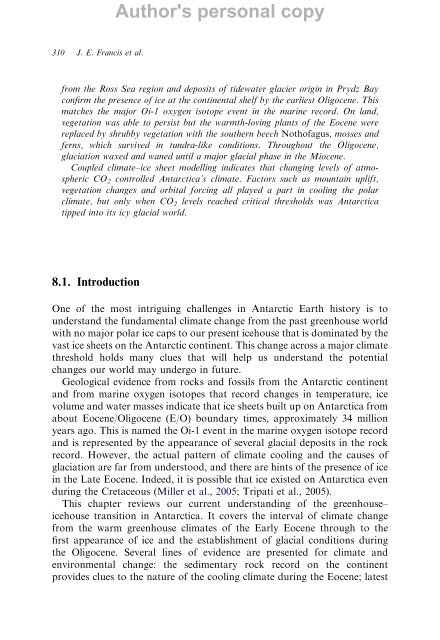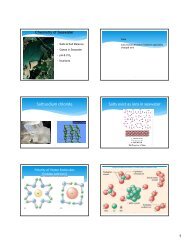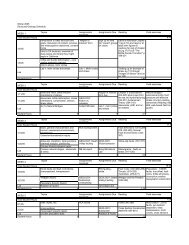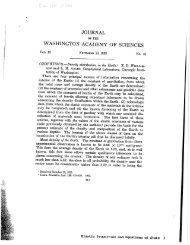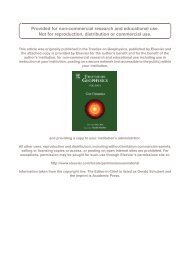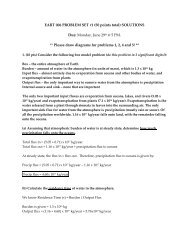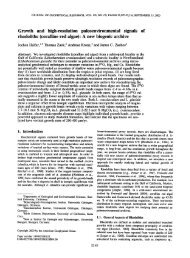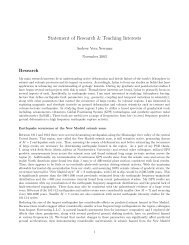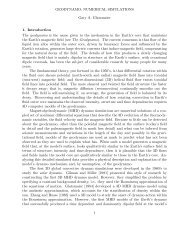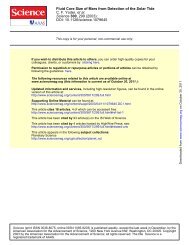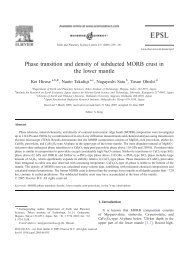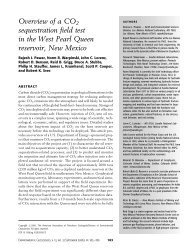From Greenhouse to Icehouse – The Eocene/Oligocene - UMass ...
From Greenhouse to Icehouse – The Eocene/Oligocene - UMass ...
From Greenhouse to Icehouse – The Eocene/Oligocene - UMass ...
You also want an ePaper? Increase the reach of your titles
YUMPU automatically turns print PDFs into web optimized ePapers that Google loves.
310 J. E. Francis et al.<br />
from the Ross Sea region and deposits of tidewater glacier origin in Prydz Bay<br />
confirm the presence of ice at the continental shelf by the earliest <strong>Oligocene</strong>. This<br />
matches the major Oi-1 oxygen iso<strong>to</strong>pe event in the marine record. On land,<br />
vegetation was able <strong>to</strong> persist but the warmth-loving plants of the <strong>Eocene</strong> were<br />
replaced by shrubby vegetation with the southern beech Nothofagus, mosses and<br />
ferns, which survived in tundra-like conditions. Throughout the <strong>Oligocene</strong>,<br />
glaciation waxed and waned until a major glacial phase in the Miocene.<br />
Coupled climate<strong>–</strong>ice sheet modelling indicates that changing levels of atmospheric<br />
CO2 controlled Antarctica’s climate. Fac<strong>to</strong>rs such as mountain uplift,<br />
vegetation changes and orbital forcing all played a part in cooling the polar<br />
climate, but only when CO 2 levels reached critical thresholds was Antarctica<br />
tipped in<strong>to</strong> its icy glacial world.<br />
8.1. Introduction<br />
Author's personal copy<br />
One of the most intriguing challenges in Antarctic Earth his<strong>to</strong>ry is <strong>to</strong><br />
understand the fundamental climate change from the past greenhouse world<br />
with no major polar ice caps <strong>to</strong> our present icehouse that is dominated by the<br />
vast ice sheets on the Antarctic continent. This change across a major climate<br />
threshold holds many clues that will help us understand the potential<br />
changes our world may undergo in future.<br />
Geological evidence from rocks and fossils from the Antarctic continent<br />
and from marine oxygen iso<strong>to</strong>pes that record changes in temperature, ice<br />
volume and water masses indicate that ice sheets built up on Antarctica from<br />
about <strong>Eocene</strong>/<strong>Oligocene</strong> (E/O) boundary times, approximately 34 million<br />
years ago. This is named the Oi-1 event in the marine oxygen iso<strong>to</strong>pe record<br />
and is represented by the appearance of several glacial deposits in the rock<br />
record. However, the actual pattern of climate cooling and the causes of<br />
glaciation are far from unders<strong>to</strong>od, and there are hints of the presence of ice<br />
in the Late <strong>Eocene</strong>. Indeed, it is possible that ice existed on Antarctica even<br />
during the Cretaceous (Miller et al., 2005; Tripati et al., 2005).<br />
This chapter reviews our current understanding of the greenhouse<strong>–</strong><br />
icehouse transition in Antarctica. It covers the interval of climate change<br />
from the warm greenhouse climates of the Early <strong>Eocene</strong> through <strong>to</strong> the<br />
first appearance of ice and the establishment of glacial conditions during<br />
the <strong>Oligocene</strong>. Several lines of evidence are presented for climate and<br />
environmental change: the sedimentary rock record on the continent<br />
provides clues <strong>to</strong> the nature of the cooling climate during the <strong>Eocene</strong>; latest


